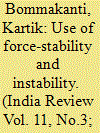| Srl | Item |
| 1 |
ID:
106453


|
|
|
|
|
| Publication |
2011.
|
| Summary/Abstract |
This article argues that most analyses of the Kargil conflict concede the important role played by the United States in understanding how India regained control of the Kargil heights, but fail to explain how India's intra-war compellent threat forced Washington to bring irresistible pressure to bear on Islamabad. The Indian decision to threaten asymmetrical escalation was the result of domestic pressures and military difficulties facing the Vajpayee-led caretaker government. The article shows that Washington pursued an "impartially" interventionist strategy until it came under Indian pressure to forsake its "balanced" approach towards ending the conflict. The article also shows how the "asymmetry of motivation" between New Delhi and Washington was an important factor in terminating hostilities in India's favor.
|
|
|
|
|
|
|
|
|
|
|
|
|
|
|
|
| 2 |
ID:
167126


|
|
|
|
|
| Summary/Abstract |
India faces a very challenging strategic environment, with its immediate opponents possessing significant capabilities and militaries that are modernizing rapidly. This article explores the opportunities, challenges and constraints confronting the Indian state in building its military strength to deal with its variegated threat environment. It examines how India has dealt with the use of force and how it seeks to shape its armed forces in the face of new threats and emerging capabilities. This article explores six key areas of enquiry and is correspondingly structured. First, how does the Indian state view the use of force? Second, what has the Indian state's recent experience been with conflict and to what extent has it influenced its thinking? Third, how does the Indian state view the future character of conflict? Fourth, what conclusions has India drawn about the role of alliances and strategic partners in dealing with the nature of the conflict it faces? Fifth, how does the Indian state intend to configure its forces to deal with this evolving nature of conflict? Finally, what do all these factors mean for its defence acquisitions? As an emerging power, India has to contend with these questions and the measures it has put in place are still a work in progress. There remains a fundamental need for greater integration across the Indian security sphere—in interservice arrangements, in procurement processes, and in broader strategic thinking and planning.
|
|
|
|
|
|
|
|
|
|
|
|
|
|
|
|
| 3 |
ID:
086539


|
|
|
|
|
| Publication |
2009.
|
| Summary/Abstract |
Raising questions about India-United States (U.S.) civilian space cooperation, arguments have been advanced that such cooperation will enable the growth of India's warhead integration capacity. This paper will demonstrate that concerns about India-U.S. civilian space cooperation leading to India's development of a Multiple Independently Retargetable Vehicle (MIRV) capability are unfounded. Despite the dual-use nature of space and missile related technologies, the analysis shows that the inference or deduction is flawed. The hypothesis adopted by proponents tends to treat integration of satellites and their orbital dispensation, and integration of multiple warheads and their delivery vehicles as though they are identical processes. Proceeding from limited evidence to substantiate their hypothesis that conflates satellite integration and warhead integration proponents have ended up obscuring and overlooking the fact that India already possesses incipient space technologies that are relevant to the development of MIRV-tipped missiles. This does not mean that it can immediately secure a full-fledged MIRV capability, because there are a range of other technical conditions that would affect its development of MIRV technology.
|
|
|
|
|
|
|
|
|
|
|
|
|
|
|
|
| 4 |
ID:
117433


|
|
|
|
|
| Publication |
2012.
|
| Summary/Abstract |
This article evaluates the source of instability and stability in the India-Pakistan dyad and the Sino-Indian dyad. Challenging the dominant thesis that "means determine ends," the article posits that the use of force by Pakistan renders the India-Pakistan relationship unstable, whereas the Sino-Indian relationship is significantly more stable because of the absence of force. The difference in the state of stability in both dyads is because the weaker state, Pakistan in its conflict with India has failed to accept the verdict of its military defeats. This failure to internalize irreversible military outcomes makes Pakistan particularly susceptible to employing forcible solutions to settle its dispute with India over Kashmir. The reality reverses in the Sino-Indian territorial dispute, in that India has implicitly accepted its military loss against China in 1962 and charted a diplomatic pathway in resolving the boundary dispute.
|
|
|
|
|
|
|
|
|
|
|
|
|
|
|
|